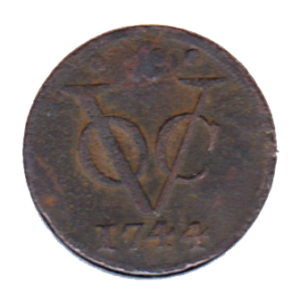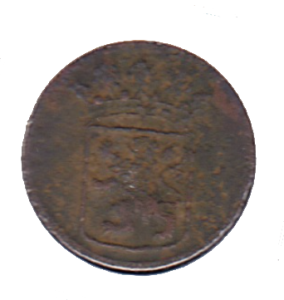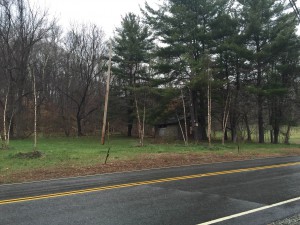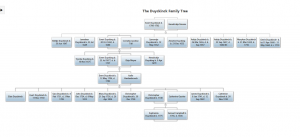Amy Ho, Gabriel Duque, Joe Terzian, Meg Tsai, Snigdaa Sethuram


The above pictured coin was found, buried in the ground, by a Rutgers student near the site of an old paper mill in Millburn, NJ, during one of his metal detecting trips. It is an original 1744 East India Company Duit, a copper coin equivalent to a modern penny. Its front (left) boasts the year and the VOC insignia, and the reverse (right) has the coat of arms of Holland, the coin’s place of mintage. These coins were also produced in Utrecht, Zeeland, and West Friesland; each province imprinted its respective coat of arms on the reverse of the coin, much like the unique insignias on the quarter here in the United States of America. Upon further inspection, this coin leads to a rich history of the family who owned the paper mill: ambitious immigrants with high hopes for their descendants.
Samuel Campbell was a Scottish immigrant who entered America with the intention of establishing a bookstore in New York City. The Campbells soon moved to New Jersey around 1785 to inhabit patch of land chartered by King Charles II, suitable for the construction of a paper mill, as well as a larger home for their growing family. The final location the Campbells chose was an area located in northern Elizabethtown (by the Newark mountains), due to its proximity to the Rahway River as well as its resemblance to Samuel’s native Scotland. Pictured below is a map of its location, as well as a modern-day photo of the plot of land they chose to build their home on, and a photo of the same location in 1899. This site is currently part of the South Mountain Reservation.


Samuel built his paper mill across the road from his home, on the banks of the Rahway River. One of the most important contracts for Samuel Campbell’s paper mill, also known as Thistle Mill, came from the U.S. Treasury Department, for the purpose of producing paper for banknotes during the Revolutionary War. His mill paved the way for the construction of even more mills in the area, and towns grew profitable around them as well. Much like the industrialization of towns leading to an increase in population and gross income much later in America, the creation of these paper mills set certain towns ahead of others. The township of Millburn itself owes its name to the Campbells—Samuel called his factory the “mill on the burn”, because “burn” means “stream” in Scottish terms, and the township adopted the name in 1857. Amazingly, the history of this coin is much richer than that of Samuel’s.
Samuel married Euphemia Duyckinck, a member of an old, well-established Dutch family. Her great-great-great-grandfather, Evert Duyckinck, emigrated to the now United States from Borkel, North Brabant, The Netherlands, sometime around 1646. The family tree below traces Euphemia’s genealogy back to her great-great-great-grandfather.

Immediately, he gained alliance with the Dutch Reformed Church in New York City, the very same church that established Rutgers University. Evert’s descendants maintained this relation to the church, some even serving as ministers in the mid-1700’s, and may have even influenced the creation of our University. This devotion to the Dutch Church included Euphemia, who married Samuel in a Dutch church.
This information has lead us to believe that the Duit belonged to either Euphemia, or a member of her family, and must have been some sort of keepsake to this individual, as the coin would hold no value during the late 1700s when the Campbells lived in their home.
It is amazing how something as small and seemingly insignificant as a coin can tell a story that spans centuries, and it is truly a testament to the widespread and impactful influence of the Dutch on our lives and our University today.
Works Cited
Bidwell, John. American Paper Mills, 1690–1832. 5th ed. Hanover: Dartmouth College, 2013. Print.
“Evert Duyckinck.” Genealogical Society of Bergen County. Ed. Joseph Boyle. Nov. 2015. Web. 1 Apr. 2016. <http://njgsbc.org/files/familyfiles/p584.htm>.
Lampe, W. Owen. Millburn: Short Hills. Charleston: Arcadia, 1999. Print.
Meisner, Marian K. A History of Millburn Township. Millburn/Short Hills Historical Society, 2002. Millburn Library. Millburn Free Public Library, 3 Sept. 2004. Web. 1 Apr. 2016.<http://millburnlibrary.org/site/1915www_/MillburnHistoryeBook.pdf>.
Sym, Jonathan. “Fun Fact: How Did Millburn Get Its Name?” TAPinto. 21 Feb. 2016. Web. 1 Apr. 2016. <https://www.tapinto.net/towns/millburn-slash-short-hills/categories/community-life/articles/fun-fact-how-did-millburn-get-its-name>.
The New York Genealogical and Biographical Record. Vol. 23. New York: New York
Genealogical and Biographical Society, 1892. Ancestral Trackers. Web. 1 Apr. 2016.<http://www.ancestraltrackers.org/ny/resources/new-york-genealogical-biographical-recordv23.pdf>.
